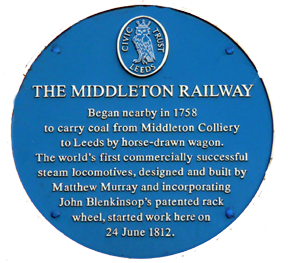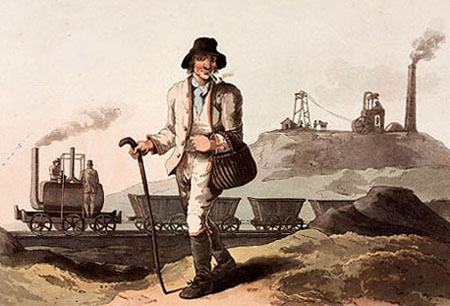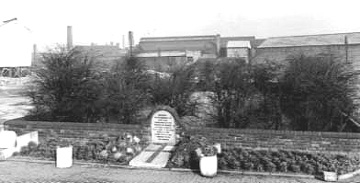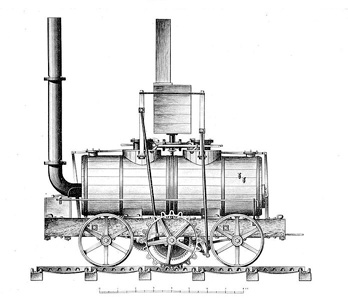Coal mining had begun in Middleton, on the southern edge of Leeds, by 1200 and possibly earlier. In 1744 Charles Brandling inherited the Middleton estate and collieries. He built the Middleton Railway to get coal to the Leeds market as the topography prevented carrying it by canal.
In 1755 he built a wooden waggonway for horse-drawn traffic from Conyers Spring in Middleton to the river Aire at Thwaite Gate. The route probably went via Belle Isle Road and Woodhouse Hill, and was used until 1807.
In 1758, following the first ever Act of Parliament authorising the construction of a railway (probably to resolve legal issues in crossing the common land of Hunslet Moor), a further waggonway branched off this route at Belle Isle and ran via Old Run Road, then along Moor Road to the end of Prospect Terrace in Hunslet Carr. From here it ran on to Leeds, alongside Hunslet Moor. Operations on part of the route were assisted by a winding engine at Old Run Cottages.
In 1808 John Blenkinsop was appointed colliery manager at Middleton. The Napoleonic wars had caused the price of horse feed to rise and the Brandlings were considering selling the colliery business because of the resulting high costs of transporting the coal, so Blenkinsop devised a solution. He designed and patented the rack and pinion method of traction.
In 1795 Matthew Murray (1765-1826) had helped establish Fenton, Murray and Wood's Round Foundry in Water Lane, Holbeck to make textile machinery, steam engines and locomotives. Blenkinsop approached the firm to requisition a steam locomotive to be designed by Matthew Murray. The rails were made at Hunslet Foundry at Carr Moor Side (later Denisons), whose owners were Gotthard and Salt.
On 24th June 1812 a public trial of what became the world's first commercially viable steam railway took place. The railway carried coal from Middleton pit down Old Run Road (hence The Engine pub, Engine Place, and Old Run Road), via Hunslet Moor, to barges on the canal in central Leeds.
Two locomotives, "Salamanca" (named after the battle three weeks earlier), and "Prince Regent" went into regular service on the 12th August. George Stephenson visited in 1813 (12 years before the Stockton and Darlington Railway opened) and his first locomotive followed Murray's design closely. The Grand Duke Nicholas of Russia (later Emperor) also came in 1816. In 1814 the colliery produced record output of 100,000 tons.
In 1755 he built a wooden waggonway for horse-drawn traffic from Conyers Spring in Middleton to the river Aire at Thwaite Gate. The route probably went via Belle Isle Road and Woodhouse Hill, and was used until 1807.
In 1758, following the first ever Act of Parliament authorising the construction of a railway (probably to resolve legal issues in crossing the common land of Hunslet Moor), a further waggonway branched off this route at Belle Isle and ran via Old Run Road, then along Moor Road to the end of Prospect Terrace in Hunslet Carr. From here it ran on to Leeds, alongside Hunslet Moor. Operations on part of the route were assisted by a winding engine at Old Run Cottages.
In 1808 John Blenkinsop was appointed colliery manager at Middleton. The Napoleonic wars had caused the price of horse feed to rise and the Brandlings were considering selling the colliery business because of the resulting high costs of transporting the coal, so Blenkinsop devised a solution. He designed and patented the rack and pinion method of traction.
In 1795 Matthew Murray (1765-1826) had helped establish Fenton, Murray and Wood's Round Foundry in Water Lane, Holbeck to make textile machinery, steam engines and locomotives. Blenkinsop approached the firm to requisition a steam locomotive to be designed by Matthew Murray. The rails were made at Hunslet Foundry at Carr Moor Side (later Denisons), whose owners were Gotthard and Salt.
On 24th June 1812 a public trial of what became the world's first commercially viable steam railway took place. The railway carried coal from Middleton pit down Old Run Road (hence The Engine pub, Engine Place, and Old Run Road), via Hunslet Moor, to barges on the canal in central Leeds.
Two locomotives, "Salamanca" (named after the battle three weeks earlier), and "Prince Regent" went into regular service on the 12th August. George Stephenson visited in 1813 (12 years before the Stockton and Darlington Railway opened) and his first locomotive followed Murray's design closely. The Grand Duke Nicholas of Russia (later Emperor) also came in 1816. In 1814 the colliery produced record output of 100,000 tons.

The Collier, by Robert Havell c.1814, showing a Matthew Murray steam locomotive, Salamanca, on the Middleton Railway

"....at four o'clock in the afternoon the machine ran from the coal staithe to the top of Hunslet Moor, where six and afterwards eight waggons of coal, each weighing three and a quarter ton were hooked to the back part. The experiment, which was witnessed by thousands of spectators, was crowned with complete success, and when it is considered that this experiment is applicable to all railroads, and that at the works of Mr Brandling alone the use of fifty horses will be dispensed with, we cannot forbear to hail the invention as of vast public utility, and to rank the inventor amongst the benefactors of the country."
The Leeds Mercury, 27th June 1812
The Leeds Mercury, 27th June 1812

Plaque at the Middleton Railway depot, Moor Road

The railway ran down Old Run Road between 1758 and 1875

This 1950 photo shows the site of a plague burial ground marked with a memorial tablet, off Moor Road. The tablet reads:
'Sacred to the memory of fifty-five inhabitants of the township of Hunslet who fell victim to the cholera in the years 1832 and 1834 whose remains were interred within this ground'
The remains and tablet were removed to make way for the M621 and are now in the new part of Hunslet cemetery opposite the end of East Grange Drive where it joins Middleton Road.
'Sacred to the memory of fifty-five inhabitants of the township of Hunslet who fell victim to the cholera in the years 1832 and 1834 whose remains were interred within this ground'
The remains and tablet were removed to make way for the M621 and are now in the new part of Hunslet cemetery opposite the end of East Grange Drive where it joins Middleton Road.
Image copyright of Leeds Library and Information Services
Hunslet Moor (2)
Memories of times spent at my grandma are seeing old horses being led across Hunslet Moor to Wilkie's Knacker's Yard; the days when the free coal would be delivered and dumped outside the house (my uncle was a miner and had an allowance). We would all set to filling buckets and carting it into the coal cellar. I remember the huge piles of stuff to burn on bonfire night stacked on Hunslet Moor (so many pianos!). The small local grocer at the end of Longroyd View was Mrs. Shires, there was a greengrocer (Mrs. Smith) on the corner of Longroyd Avenue, Johnson's Butchers at the end of one of the Garnets (they would scrub their wooden tables out on the street at the end of the day), a very smart grocer, Mr. Tiller, who had a double shop at the back of Hunslet Moor School who wore a white coat and weighed out butter, loose biscuits and cream crackers from large tins and cut bacon rashers to the desired thickness. There was another butcher (Mr Allison, I think), at the top of one of the streets now opposite the police station, which is now a hairdresser. He had whole carcases hanging from hooks from the ceiling and often had a pig or sheep's head in the window, which made us giggle. Never tasted sausages like his since. Hunslet Moor was much bigger then and had an area with council maintained flower beds, children's playground and a stone drinking fountain.
Julie Gallagher (nee Stephenson) was born in 1958
Julie Gallagher (nee Stephenson) was born in 1958

Salamanca
Blenkinsop died in 1831 and is buried in the churchyard at Rothwell Parish Church. Murray died in 1826 and is buried in St.Matthew's Churchyard, Holbeck.
By the 1830s the route reverted to using horse-drawn wagons, but by 1866 steam was used again. In 1875 the incline along Old Run Road was avoided by building the present day line, further to the west.
In the late 19th century a coal depot was built on Hunslet Moor. This became the line's northern terminus in 1947.
In 1961 the link from this depot to the link to the Midland line (south of Prospect Terrace) was closed.
In1967 the last coal left Middleton by rail, and Broom Pit closed in 1968.
The routes that the railway took through Hunslet are marked on the Hunslet Carr, Hunslet Moor, Parkside and Pottery Field maps.
External links:
Middleton Railway: The Trust's website
Wikipedia article
By the 1830s the route reverted to using horse-drawn wagons, but by 1866 steam was used again. In 1875 the incline along Old Run Road was avoided by building the present day line, further to the west.
In the late 19th century a coal depot was built on Hunslet Moor. This became the line's northern terminus in 1947.
In 1961 the link from this depot to the link to the Midland line (south of Prospect Terrace) was closed.
In1967 the last coal left Middleton by rail, and Broom Pit closed in 1968.
The routes that the railway took through Hunslet are marked on the Hunslet Carr, Hunslet Moor, Parkside and Pottery Field maps.
External links:
Middleton Railway: The Trust's website
Wikipedia article

